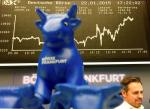
- All Instrument Types
- Indices
- Equities
- ETFs
- Funds
- Commodities
- Currencies
- Crypto
- Bonds
- Certificates
Please try another search

The UK labour market has shown its mettle yet again, after cooling off a little in recent months, the UK is once again creating jobs at a rapid clip. Comparing the three months to February with the previous three months, the number of employed people increased by 239k, the number of unemployed people fell by 77,000 and the number of adults not in the labour force fell by 86,000.
The number of employed people has picked up by an impressive 691k over the last 12 months, with 72.6% of all adults now in work. That is the equivalent of over 30 million, which is a fresh record high. The number of people claiming jobless benefits last month was at the lowest since 2008, which could help George Osborne reign in the welfare budget as we lead up to next year’s elections.
The North/South divide remains
From a regional perspective the North/ South divide remains in place, which could be a sticking point for the current government in the next election. The South East continues to have the highest employment rate and one of the lowest unemployment rates, while the North, particularly the North East has the highest unemployment rate in the country at 9.3%, and the highest percentage of people claiming jobless benefits at 5.5%, while in the South East the rate is a mere 1.9%.
On an international level, the UK has one of the highest employment rates in the EU, behind Austria, Netherlands, Germany and Sweden, as you can see in figure 2.
Are we getting richer? It depends who you work for…
It appears that some of the overall labour market strength is seeping into our wage packets, average wages including bonuses rose by 1.7%, above the rate of inflation (which is 1.6%), and the first real increase in wages since 2010. Average weekly wages are now GBP 479 including bonuses. It is slightly higher in the public sector compared to the private sector; however rates of wage growth are much stronger in the private sector at 2%, while in the public sector it is only 0.9%.
Thus, in real terms (when adjusting for inflation) public sector wage growth is actually negative, while for the private sector it continues to extend into positive territory. So is the British public getting richer again? Yes and no. You may actually feel richer if you work in the private sector, even though you earn less than your public sector counter-parts.
UK economic round up for April:
• Construction is strong.
• House prices continue to move higher, particularly in the South East.
• The latest services and manufacturing PMI surveys continue to moderate but remain comfortably in expansionary territory.
• Retail sales are a weak spot.
• CPI is falling.
• The labour market is strong.
We have said that this is a sweet spot for the UK economy in prior reports, but how long can it last? The markets have slightly nudged up the prospect of a rate hike in the UK to the end of Q1 2015, but overall rate expectations have not changed much on the back of this labour market data. This may suggest that the bond market believes weak inflation, rather than a fall in the unemployment rate to 6.9% is the chief concern of the BOE right now.
What does this mean for the pound?
Sterling rallied into the number but has failed, so far, to get above 1.6823, the high from 17th February. The reluctance to push us above this key resistance level could be down to holiday-thinned markets that are triggering some profit taking. But the strength of this labour market report was a surprise, which makes it hard to justify that all of the good news surrounding the UK economy is already in the price, so there may be the potential for further upside. As you can see in chart 1, the yield spread is also back in the pound’s favour, which could also support further upside.
Key support lies at 1.6657 – the 61.8% Fib retracement of the latest advance. A break below here would be a short term bearish development, while a break above 1.6823 resistance opens the way to 1.7043 – a critical resistance zone and the highest level since August 2009.
Ditching the 7% unemployment rate threshold has made life easier for the BOE, but they should keep an eye on wage price inflation. If we see further gains in the coming months then the Bank may have no choice but to raise rates sooner than the market expects.
Figure 1
Source: Forex.com and Bloomberg
Figure 2:
Source: Office for National Statistics





